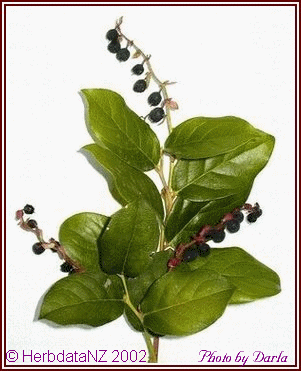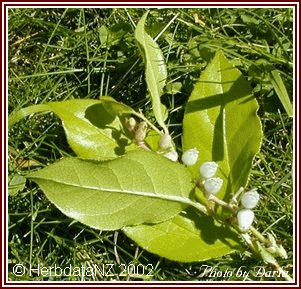

Gaultheria shallon, Pursh
Synonym : Salal
Nat Ord : Ericaceae
Part used : Berries
Description : An evergreen upright or prostate shrub. The leaves are
alternate, leathery, and ovoid to 10 cm (4") long, they are finely toothed.
The flowers are shaped like a Greek urn and are white running into pink.
They flower from May to July in Oregon. They are to be found in Coastal
forests to approximately 800 m .Fruits are of a deep reddish blue to a
dark-purple capsule surrounded by adnate, the fleshy sepal appears as a
berry. They start to mature from August and persist until October.
In season the juicy berries were greatly esteemed by the Indigenous or first
peoples of North West America. Ones eye is drawn to images of the women,
with hordes of laughing calling children with purple stained mouths.
Gathering a most important crop for the welfare of their group, during those
frozen winter months.
 The
berries were eaten either fresh or dried in the form of cakes rather like
unleavened bread. Where they were a ready item of barter. In that form they
would also be blended according to group custom with other berries for
example elder berries or the various currants. The fresh young growing tips
were chewed to supress hunger and would no doubt have served well during the
men's extended hunting trips as they tracked the game.
The
berries were eaten either fresh or dried in the form of cakes rather like
unleavened bread. Where they were a ready item of barter. In that form they
would also be blended according to group custom with other berries for
example elder berries or the various currants. The fresh young growing tips
were chewed to supress hunger and would no doubt have served well during the
men's extended hunting trips as they tracked the game.
Medicinal Action :
Nutrient and urinary disinfectant :
Salal is of the same
family as wintergreen and uva ursi. it may be taken that members of the same
family will have similar properties to a greater or lesser degree. these
plants may be used with confidence by women who suffer with candida or
thrush. They will restore the natural acidity of the intimate enviroment,
thus making it impossible for the yeasts to flourish. As a nutrient they
will contain much vitamin 'C' an essential for fighting a cold in season. In
addition they will contain many of the essential trace elements which are
lacking in traditional winter diets.
Further information on this most useful North American plant may be
obtained from the University of Michigan - Native American Ethnobotany Data
base: http://herb.umd.umich.edu/
![]()